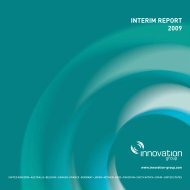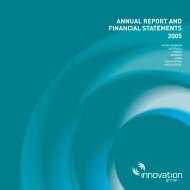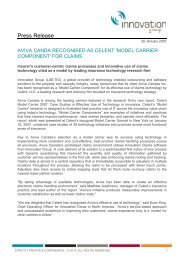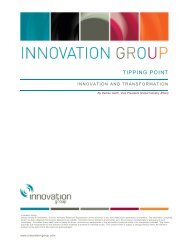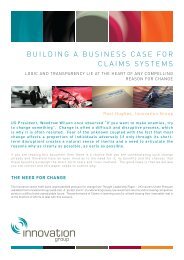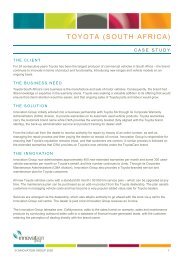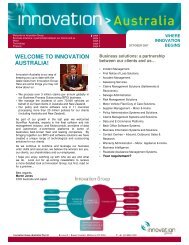View Article - Innovation Group
View Article - Innovation Group
View Article - Innovation Group
You also want an ePaper? Increase the reach of your titles
YUMPU automatically turns print PDFs into web optimized ePapers that Google loves.
www.business-standard.com<br />
History has put IBM and Amul in<br />
two different worlds. IBM is a<br />
key flag bearer of the US in global<br />
business. It got thrown out of<br />
India in the late 1970s as the last<br />
gasp of the Third World desire to rid itself<br />
of the neo-colonial yoke. Amul is not<br />
just a flag bearer of desicompetitiveness<br />
but an icon of the cooperative movement<br />
to boot. Still, Gujarat Cooperative Milk<br />
Marketing Federation, which owns the<br />
Amul brand, recently outsourced its information<br />
technology operations to IBM.<br />
This will help Amul become even more<br />
competitive as it will get equipped with<br />
a state-of-the-art IT system that weaves<br />
the automated village milk collection<br />
centre and the management<br />
information system into a<br />
seamless whole.<br />
For well over a decade, Indian<br />
software services leaders<br />
have taken the world by storm<br />
by recording exceptional growth<br />
and industry-beating margins.<br />
But even as they have done this,<br />
they have not adequately looked<br />
at their own backyard, the domestic<br />
market. There, with a<br />
minimum of noise, IBM has<br />
emerged as the largest player<br />
with a 10.8 per cent share of the<br />
Indian domestic IT services<br />
market in 2008, according to the<br />
analyst and IT market research<br />
firm Springboard Research.<br />
This, in itself, would not<br />
have mattered that much to the<br />
Indian players were it not for<br />
the fact that the global economy<br />
tanked the same year and<br />
took the developed world’s IT<br />
spending decisions with it. Even<br />
more dramatically, the Indian<br />
government woke up to the<br />
need to sharply up IT spending<br />
and UPA II took giant strides to<br />
e-enable governance. Suddenly,<br />
the Indian market was the<br />
growth engine which no one<br />
could ignore and there was<br />
IBM at the head of the pack.<br />
According to Dataquest, in<br />
2008-09, IBM’s total business<br />
grew 19 per cent, whereas<br />
those of its competitors like<br />
Cisco, Oracle and HP grew by<br />
under 5 per cent. If you exclude<br />
domestic business process outsourcing,<br />
IBM’s top-line growth was even<br />
more impressive at 36 per cent. This<br />
growth took the domestic revenue share<br />
(excluding exports) of IBM’s revenue<br />
from 42 per cent to 48 per cent. In 2008,<br />
IBM’s India business grew the fastest<br />
among the BRIC countries.<br />
How has this happened? IBM India<br />
Managing Director Shanker Annaswamy<br />
says: “IBM is fundamentally a different<br />
company than what we were a decade<br />
ago. We have remixed our portfolio to focus<br />
on what one would call ‘higher-value’<br />
spaces, including high-end hardware,<br />
software and services.” It has significantly<br />
improved service margins globally over<br />
the past five years by automating labourbased<br />
processes and creating intelligent,<br />
software-like assets. “In India, we have<br />
been successful at replicating our<br />
telecommunications expertise in business<br />
model transformation in emerging<br />
sectors such as insurance (Reliance Life),<br />
FMCG (Cavincare), infrastructure (Hiranandani)<br />
and pharmaceuticals (Torrent),”<br />
says Annaswamy.<br />
THE DRIVE FOR SMALL AND MEDIUM BUSINESSES<br />
HAS BROUGHT IN NEW CATEGORIES OF<br />
CUSTOMERS LIKE PRIVATE HOSPITALS,<br />
EDUCATIONAL INSTITUTIONS AND COOPERATIVE<br />
BANKS THAT WISH TO BECOME PROFESSIONAL<br />
Saving costs<br />
Explains Mukul Mathur, director of the<br />
company’s systems and technology group,<br />
IBM’s Indian and global strategy is to move<br />
on the two legs of consultancy and systems<br />
integration towards high-value enterprisecritical<br />
solutions. Along with this has been<br />
the strategy to show customers that partnering<br />
IBM, using its servers, can cut costs.<br />
Seventy per cent of IT expenditure goes in<br />
meeting infrastructure maintenance costs.<br />
IBM GOES DESI<br />
The IT major is working with a host of Indian companies in emerging<br />
sectors to enable them to improve efficiency and cut costs — spelling<br />
both good business and sound investment for the future<br />
Greater energy efficiency of servers means<br />
lower air-conditioning and backup costs.<br />
To this is added the cost-saving<br />
achieved by sharing servers as, research<br />
shows, 85 per cent of server capacity goes<br />
unused. Reducing client and own costs<br />
goes hand in hand. Since 1997, IBM has<br />
reduced its global data centres, where<br />
clients increasingly host their computing<br />
and data, from 155 to seven! IBM is still<br />
number two in India (behind HP) in server<br />
revenue but it is catching up fast and<br />
Annaswamy claims that it does not run<br />
for the sake of numbers but keeps an eye<br />
on how paying the business is. However,<br />
it leads in non-x86 Unix-based servers<br />
and also in external disc storage.<br />
IBM in India has also gone after<br />
small and medium businesses.<br />
Serving such customers should be<br />
difficult for a global firm with its<br />
overheads and preponderance of<br />
large customers who can be efficiently<br />
served in a distributed manner<br />
round the world. Small businesses<br />
in India, for their part, could<br />
feel overawed and sceptical about<br />
engaging with a firm of the size of<br />
IBM. So, the approach has been,<br />
says Jyothi Sathyanathan, vicepresident<br />
for the mid-market segment,<br />
to offer as simple a solution<br />
as possible where the customer acquires<br />
a capability which he can<br />
virtually “plug and play”. To reach<br />
such customers, IBM India is<br />
spreading out from metros into Tier<br />
II and III towns.<br />
The main platform through<br />
which customers are served is<br />
Smart Business. “It does not customise<br />
solutions but offers options<br />
in terms of packages and features<br />
off the shelf, not tailored garments<br />
but T-shirts of many sizes and standard<br />
designs,” explains Sathyanathan.<br />
And there is great flexibility<br />
in terms of whether you want<br />
to host, manage or share, in dif-<br />
ferent combinations of the three.<br />
This drive for small and medium<br />
businesses has brought in new<br />
categories of customers like private<br />
hospitals, educational institutions<br />
and cooperative banks<br />
that wish to become professional.<br />
A private hospital should be<br />
able to give a patient checking out<br />
his bill with the same speed as a hotel.<br />
A private engineering college should be<br />
able to digitise its course content so as<br />
to build a reputation that will bring in<br />
good students who will then go on to get<br />
good placements.<br />
P Kulkarni, who was till lately managing<br />
director of Pune-based Mahesh Sahakari<br />
Cooperative Bank, recalls that in<br />
2006 it had engaged IBM for the installation<br />
of hardware and networking for core<br />
Subir Roy<br />
T U E S D A Y 22 DECEMBER 2 0 0 9<br />
Shanker Annaswamy,<br />
Managing Director, IBM India<br />
BS PHOTOS<br />
banking at a project cost of just under Rs<br />
2 crore, including replacement of desktops.<br />
Core banking was installed in August<br />
2008 but not without some effort as<br />
“initially there was resistance from staff<br />
who had to be given training.” The bank<br />
has ten branches plus head office, done<br />
Rs 550 crore of business, and clocked a net<br />
profit of Rs 3.5 crore. “We had a good experience<br />
of IBM which was not just the<br />
vendor but also guided us, setting aside<br />
concerns for its own sales. We never felt<br />
IMB was a very big company. It often sent<br />
very senior representatives to us and gave<br />
us a one-point contact,” says Kulkarni.<br />
<strong>Innovation</strong> Auto Risk is a joint venture<br />
between <strong>Innovation</strong> (turnover: £140<br />
million) and Auto Risk (Rs 19 crore). It<br />
has a full-time staff of 30 and works<br />
through a network of 1,400 engineers who<br />
work through regional offices. Says Director<br />
Manu Mehta: “We offer a claim<br />
management solution in motor insurance.<br />
We needed a portal and a facility to host<br />
our software. Our main requirement was<br />
connectivity and speed.” When a truck<br />
meets with an accident, the insured gets<br />
in touch with Auto Risk, which helps him<br />
to lodge a claim through their portal.<br />
Recalls Mehta: “The hardware and<br />
software were tested by calling us from<br />
remote parts of the country. The crucial<br />
thing was how soon we could be reached.”<br />
Auto Risk has a data centre at its office<br />
which has been created and is served and<br />
run remotely by IBM. “We are capitalising<br />
its cost, close to $1.5 million, over five<br />
years.” The agreement with IBM, signed<br />
in July, is getting off the ground now.<br />
<strong>Innovation</strong> hub<br />
Annaswamy adds: “IBM has treated<br />
India as an innovation hub and a<br />
market with immense potential. There<br />
is a lot of interesting work that we do in<br />
our Indian research labs and software labs<br />
where we have created solutions keeping<br />
the Indian clients and business landscape<br />
in mind.”<br />
� CONTINUED ON PAGE 3
It recently showcased some<br />
of the latest technologies developed<br />
like the medical analytics<br />
platform, drug pedigree<br />
and traceability solutions,<br />
and threat and fraud detection<br />
solution.<br />
At another end is the Spoken<br />
Web project, one of the innovative<br />
initiatives currently<br />
being piloted by the India research<br />
team which aims to<br />
transform how people create,<br />
build and interact with information<br />
using the spoken instead<br />
of the written word. The<br />
Spoken Web is the World Wide<br />
Web in a telecom network,<br />
where people can host and<br />
SINCE 2007,<br />
IBM HAS EXPANDED<br />
ITS PRESENCE IN<br />
14 NEW CITIES. IT<br />
IS FOCUSING ON<br />
NEW PRODUCTS<br />
AND SERVICES AND<br />
STRENGTHENING<br />
THE CHANNEL<br />
NETWORK IN<br />
THE COUNTRY<br />
browse “VoiceSites”, traverse<br />
“VoiceLinks”, even conduct<br />
business transactions, all just<br />
by talking over the existing<br />
telephone network.<br />
Does IBM, which does not<br />
share India-specific figures,<br />
make money in India, aside<br />
of exports? Annaswamy recalls<br />
that since 2007 it has invested<br />
in the domestic market<br />
and expanded its presence<br />
in 14 new cities. Today, it continues<br />
to invest and focus in<br />
more cities and sectors, bringing<br />
in new products and services<br />
and strengthening the<br />
channel network. “In addition,<br />
we continue to leverage<br />
our global footprint to help<br />
clients in India.” It works the<br />
other way too. For example,<br />
as a result of its strong relationship<br />
with Bharti Airtel, it<br />
has been able to generate takeaways<br />
that have helped it<br />
serve other telecom clients<br />
elsewhere in the world.<br />
So IBM India seems to be<br />
in the “investment mode”,<br />
which means it is building resources<br />
here. Industry sources<br />
say that what it does for the Indian<br />
market clearly makes<br />
money today but the investments<br />
are aimed at making<br />
things better for the future.<br />
Globally, IBM is doing well and<br />
India is a part of its global<br />
scheme of things.<br />
� CONTINUED FROM PAGE 1<br />
IBM GOES DESI<br />
IBM’s office in Bangalore<br />
...AND THE BIG THREE<br />
Dismissed until recently<br />
as a low-margin business,<br />
the domestic market<br />
has come to hold the key<br />
for Indian IT companies.<br />
Some top companies have<br />
been vying for projects in their<br />
own backyard. Last week,<br />
Wipro, Infosys, TCS and others<br />
bid for the home ministry’s<br />
Rs 2,000-crore online FIR<br />
(first information report) project<br />
to devise an automated<br />
complaint filing and tracking<br />
system across the country.<br />
Winning strategy<br />
In May, Wipro went past rivals<br />
IBM, Tech Mahindra and<br />
TCS to bag the Rs 2,200-crore,<br />
nine-year contract from<br />
Unitech Wireless which is<br />
rolling out mobile services in<br />
the country. Earlier this year,<br />
Wipro had signed a contract<br />
worth Rs 3,000 crore with<br />
Aircel and got an e-governance<br />
order of Rs 1,182 crore<br />
from the Employees’ State Insurance<br />
Corporation.<br />
The price quoted by<br />
Wipro in most of the recent<br />
bids is said to be far below rivals’,<br />
which has helped it bag<br />
deals. For instance, the company’s<br />
quote of Rs 1,182 crore<br />
for the ESIC bid was way lower<br />
than TCS’ Rs 1,530 crore<br />
and Infosys’ Rs 1,791 crore.<br />
What has worked in its<br />
favour, says the company, is<br />
its emergence as “an end-toend<br />
solution player.” The<br />
company spent time till 1987<br />
“establishing a pedigree in<br />
hardware”, concentrated<br />
next on systems integration<br />
and networking, graduated<br />
to professional services and<br />
managed IT services, and<br />
has now got into application<br />
development and consulting.<br />
This, according to<br />
Wipro, has helped it bag<br />
large multi-layered deals like<br />
Unitech Wireless.<br />
Wipro has also mastered<br />
the art of transaction-based<br />
pricing which has played a<br />
key role in the recent orders<br />
it has won. For instance, a<br />
bank will be billed<br />
for each customer<br />
transaction rather<br />
than a pre-decided<br />
sum. If footfalls increase,<br />
it’s a winwin<br />
situation for<br />
both the bank and<br />
the IT vendor. If<br />
there’s a fall in the<br />
customer base, the<br />
risk is contained for<br />
the bank. This is opposed<br />
to outcome-based pricing<br />
where the bank shells out<br />
a huge sum of money upfront.<br />
Strong footprint<br />
TCS, the country’s largest information<br />
technology company,<br />
is not far behind. In September,<br />
the company won the<br />
country’s largest State Wide<br />
Area Network (SWAN) project<br />
from the Andhra Pradesh<br />
THE DOMESTIC<br />
MARKET HAS<br />
COME TO HOLD<br />
THE KEY FOR<br />
INDIAN IT<br />
COMPANIES SUCH<br />
AS TCS, WIPRO<br />
AND INFOSYS<br />
government on a five-year<br />
build, own, operate and transfer<br />
model. On implementation,<br />
government offices in<br />
1,088 mandals and 23 district<br />
headquarters in Andhra<br />
Pradesh will have video conferencing<br />
facility. In October<br />
last year, it signed a Rs 1,200crore<br />
deal with the Government<br />
of India to migrate passport<br />
services to the electronic<br />
platform.<br />
TCS expects to double the<br />
revenue from the country over<br />
the next three or four years.<br />
According to Country Head<br />
(India business) G S Raghavan,<br />
“The com-<br />
pany believes in<br />
bringing its entire<br />
branding and<br />
global experience<br />
to its local<br />
clients.” Like<br />
Wipro and IBM,<br />
it has an integrated<br />
business<br />
unit (as opposed<br />
to just sales offices)<br />
to address<br />
customer acquisition, management<br />
and delivery. The<br />
company has around 12,000<br />
people dedicated to the India<br />
business. TCS has a very<br />
strong footprint in the finance<br />
sector which happens to be<br />
the largest buyer of IT services<br />
in the country. Fifteen of the<br />
top 30 players in the industry<br />
are its customers. Five of the<br />
top 10 Indian retailers are its<br />
BLOOMBERG<br />
customers too. In the insurance<br />
sector, it works with 15<br />
of the 24 players.<br />
Experts say TCS is the<br />
company to watch in the domestic<br />
space because of the<br />
work it has done with the central<br />
and state governments.<br />
The space poses a Rs 24,000<br />
crore-Rs 48,000 crore opportunity<br />
over the next five years<br />
for TCS as the government<br />
plans to roll out its 30 mission<br />
mode projects (of which TCS<br />
has already bagged two).<br />
Growing presence<br />
Infosys, too is getting its feet<br />
wet here. India contributes<br />
around 1.3 per cent to its total<br />
revenues, the larger part<br />
of which comes from its banking<br />
product, Finacle. Last year,<br />
however, it announced the<br />
formation of a separate business<br />
unit to focus on just the<br />
domestic market. Infosys<br />
signed an e-governance deal<br />
with the Income Tax Department<br />
to establish back-office<br />
hubs in four states. In the private<br />
sector, the company has<br />
about six customers including<br />
Thermax. And it is ready<br />
to up the ante. In June, the<br />
company bagged a prestigious<br />
10-year eBiz project of<br />
the Department of Industrial<br />
Policy and Promotion in a bid<br />
which also saw participation<br />
from TCS, HCL and Wipro<br />
among others. Infosys will develop<br />
and maintain the eBiz<br />
portal which will work as a<br />
one-stop shop to provide efficient<br />
services to investors,<br />
business and industry.




